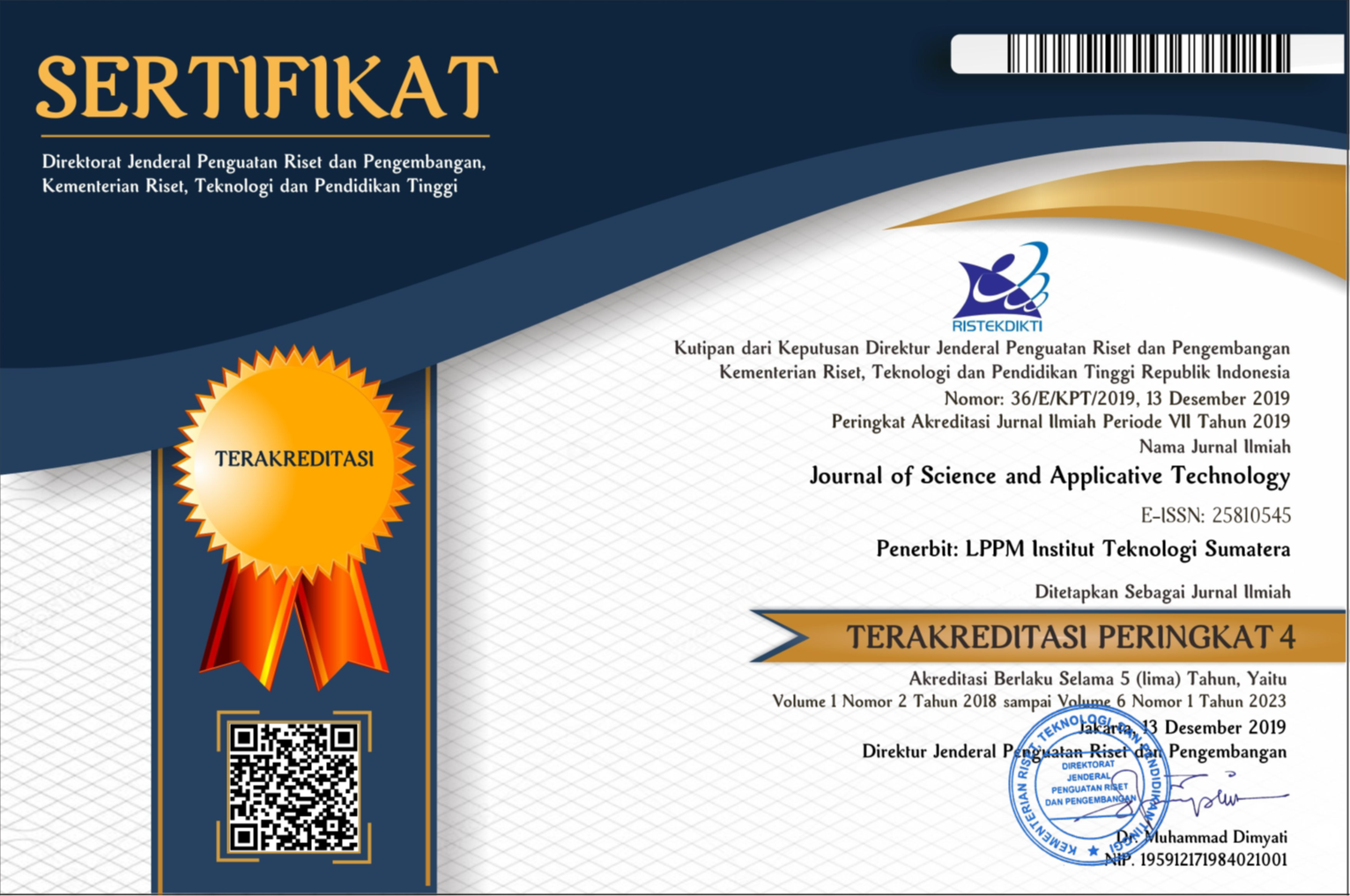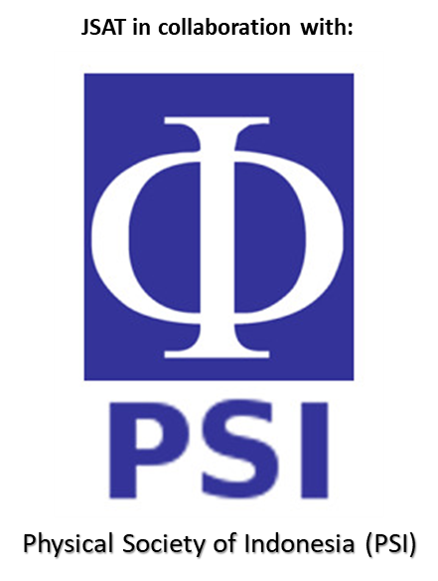Karakteristik dan Aplikasi Selulosa Kulit Jagung Pada Pengembangan Hidrogel
Abstract
Corn is one of the staple food crops widely consumed by Indonesians, thus has potensial in producing an abundant amount of corn husk waste. Cellulose contained in corn husk is about 44%, so the material has the potential to be source of natural fiber cellulose. The development of hydrogels from natural polymers such as cellulose is very promising especially for biomaterial application. Cellulose fiber was obtained through several stages: dewaxing, pulping, delignification, bleaching and cellulose purification. This study aimed to determine the most effective solvent in cellulose extraction of corn husk, the research carried out with different solvent such as, hydrogen peroxide (H2O2), sodium hypochlorite (NaOCl) and hydrocloric acid (HCl). Based on the functional group formed on the analysis of FTIR, shows that the extraction method using H2O2 as solvent can remove hemicellulose and lignin from the cellulose structure and the most white cellulose fiber obtained from the extraction with H2O2 solvent. Cellulose obtained from previous step was used for hydrogel production. The hydrogel showed different absorption capacity depend on temperature and ratio of glutaraldehide to cellulose. The highest water absorption capacity of 250% obtained by hidrogel with ratio 1:2 at 25oC.
Downloads
References
[2] Faesal, “Pengolahan Limbah Tanaman Jagung Untuk Pakan Ternak Sapi Potong,†Semin. Nas. Inov. Teknol. Pertan., no. 19, pp. 181–190, 2013.
[3] T. K. Fagbemigun, O. D. Fagbemi, O. Otitoju, E. Mgbachiuzor, and C. C. Igwe, “Pulp and paper-making potential of corn husk,†Int. J. AgriScience, vol. 4, no. 44, pp. 209–213, 2014.
[4] W. M. Putra, A. Fathony, F. I. Sari, S. A. Satyawardhani, and S. Bakti, “Pemanfaatan Limbah Kulit Jagung (Zea Mays) sebagai komposit pembuatan sumpit makan,†Depok, 2012.
[5] S. S. Kwon, B. J. Kong, and S. N. Park, “Physicochemical properties of pH-sensitive hydrogels based on hydroxyethyl cellulose-hyaluronic acid and for applications as transdermal delivery systems for skin lesions,†Eur. J. Pharm. Biopharm., vol. 92, no. March, pp. 146–154, 2015, doi: 10.1016/j.ejpb.2015.02.025.
[6] N. Masruchin, B. D. Park, and V. Causin, “Influence of sonication treatment on supramolecular cellulose microfibril-based hydrogels induced by ionic interaction,†J. Ind. Eng. Chem., vol. 29, pp. 265–272, 2015, doi: 10.1016/j.jiec.2015.03.034.
[7] K. Abe and H. Yano, “Formation of hydrogels from cellulose nanofibers,†Carbohydr. Polym., vol. 85, no. 4, pp. 733–737, 2011, doi: 10.1016/j.carbpol.2011.03.028.
[8] J. P. de Oliveira et al., “Cellulose fibers extracted from rice and oat husks and their application in hydrogel,†Food Chem., vol. 221, pp. 153–160, 2017, doi: 10.1016/j.foodchem.2016.10.048.
[9] X. Zhang, Y. Wang, C. Lu, and W. Zhang, “Cellulose hydrogels prepared from micron-sized bamboo cellulose fibers,†Carbohydr. Polym., vol. 114, pp. 166–169, 2014, doi: 10.1016/j.carbpol.2014.08.012.
[10] X. Hu, K. Hu, L. Zeng, M. Zhao, and H. Huang, “Hydrogels prepared from pineapple peel cellulose using ionic liquid and their characterization and primary sodium salicylate release study,†Carbohydr. Polym., vol. 82, no. 1, pp. 62–68, 2010, doi: 10.1016/j.carbpol.2010.04.023.
[11] R. D. . Putera, “Ekstraksi serat selulosa dari tanaman eceng gondok (eichornia crassipes) dengan variasi pelarut,†Universitas Indonesia, 2012.
[12] S. L. M. El Halal et al., “Films based on oxidized starch and cellulose from barley,†Carbohydr. Polym., vol. 133, pp. 644–653, 2015, doi: 10.1016/j.carbpol.2015.07.024.
[13] A. Alemdar and M. Sain, “Isolation and characterization of nanofibers from agricultural residues - Wheat straw and soy hulls,†Bioresour. Technol., vol. 99, no. 6, pp. 1664–1671, 2008, doi: 10.1016/j.biortech.2007.04.029.
[14] M. L. Hassan, A. P. Mathew, E. A. Hassan, and K. Oksman, “Effect of pretreatment of bagasse pulp on properties of isolated nanofibers and nanopaper sheets,†Wood Fiber Sci., vol. 42, no. 3, pp. 362–376, 2010.
[15] E. Kayalvizhy and P. Pazhanisamy, “Swelling behavior of poly(N-cyclohexylacrylamide-co-acrylamide/AMPSNa) gold nanocomposite hydrogels,†Int. J. Biol. Macromol., vol. 86, pp. 721–727, 2016, doi: 10.1016/j.ijbiomac.2016.01.047.
All the content on Journal of Science and Applicative Technology (JSAT) may be used under the terms of the Creative Commons Attribution-NonCommercial 4.0 International License.
You are free to:
- Share - copy and redistribute the material in any medium or format
- Adapt - remix, transform, and build upon the material
Under the following terms:
- Attribution - You must give appropriate credit, provide a link to the license, and indicate if changes were made. You may do so in any reasonable manner, but not in any way that suggests the licensor endorses you or your use.
- NonCommercial - You may not use the material for commercial purposes.
- No additional restrictions - You may not apply legal terms or technological measures that legally restrict others from doing anything the license permits.





















